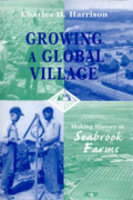
- 2003/176 pages
- Distributed for Holmes & Meier Publishing
Growing a Global Village:
Making History at Seabrook Farms
Hardcover: $29.95
ISBN: 978-0841914285
In the first half of the twentieth century, a small corner of southern New Jersey became the first and probably the only rural global village of its kind and size in America. Here, in a township that did not appear on most state maps, thousands of men, women, and children from more than 20 countries and speaking as many languages, most of them uprooted and displaced by war or poverty, came to work at what Life magazine called in 1955, "the biggest vegetable factory in the world." That factory was Seabrook Farms, which pioneered frozen vegetables for Clarence Birdseye and became the prime provisioner for America's fighting men in both World Wars and the free world's population as well.
Meet some of the people who worked and lived together harmoniously when multiculuralism wasn't even a word: Japanese American families who had been sent off to internment camps by their own government, Europeans who came from displaced persons camps, out-of-work mountain people who drove north from Appalachia, dark-skinned men from the West Indies who spoke with British accents and preferred cricket to baseball, and so many others. This extraordinary population formed the base of a very remarkable food processing operation.
C.F. Seabrook, engineer, farmer, astute businessman, and visionary was born a farmer—and hated farming. A self-taught engineer, he found that he could overcome his aversion to dirt by combining agriculture and industry. He pioneered in overhead irrigation and frozen food manufacture and built Seabrook Farms into the first industrial farming operation in America. Was he a humanitarian? Rather, he was a shrewd businessman who hired rather cheaply people who came to his village in desperate need of jobs—but he treated those workers with affection and respect.
Charles H. Harrison has written a compelling study of the Seabrook Farms global village. Combining the technological history of agriculture and the social history of its labor force, Growing a Global Village offers a heartening and enlightening look at an important but little known episode in America's past.
Meet some of the people who worked and lived together harmoniously when multiculuralism wasn't even a word: Japanese American families who had been sent off to internment camps by their own government, Europeans who came from displaced persons camps, out-of-work mountain people who drove north from Appalachia, dark-skinned men from the West Indies who spoke with British accents and preferred cricket to baseball, and so many others. This extraordinary population formed the base of a very remarkable food processing operation.
C.F. Seabrook, engineer, farmer, astute businessman, and visionary was born a farmer—and hated farming. A self-taught engineer, he found that he could overcome his aversion to dirt by combining agriculture and industry. He pioneered in overhead irrigation and frozen food manufacture and built Seabrook Farms into the first industrial farming operation in America. Was he a humanitarian? Rather, he was a shrewd businessman who hired rather cheaply people who came to his village in desperate need of jobs—but he treated those workers with affection and respect.
Charles H. Harrison has written a compelling study of the Seabrook Farms global village. Combining the technological history of agriculture and the social history of its labor force, Growing a Global Village offers a heartening and enlightening look at an important but little known episode in America's past.





